ICTICT418: Detailed Review of Copyright, Privacy, and Ethical Policy
VerifiedAdded on 2023/03/30
|15
|4155
|420
Report
AI Summary
This report provides a comprehensive review of copyright, privacy, and ethical policies within an ICT environment, specifically addressing the ICTICT418 assignment. It begins with an analysis of Australian legislation related to intellectual property and copyright, referencing the document 'An Introduction to Copyright in Australia' and its applicability to organizations like APRA AMCOS. The report identifies three key areas covered by copyright legislation, detailing the requirements for copyright, registration, and loyalty. It reviews an existing organizational policy, recommending changes for alignment with legislation and industry standards, including procedures for assigning or licensing copyrights, publishing work in public, addressing copyright violations, and defining rights to rent. The report also outlines procedures for managing copyright, such as protecting materials from illegal access, and distributing revised policies to various stakeholders. Furthermore, the report reviews privacy policies, focusing on the ARQ Group, and compares them against the Australian Privacy Principles (APPs), recommending modifications and outlining distribution strategies. Finally, the report investigates and compares the code of ethics of Sage Business Solutions with the ACS code of ethics, highlighting key ethical principles and suggesting improvements for effective ethical conduct. The analysis ensures that the recommendations adhere to legislative requirements and APP principles, covering data integrity, confidentiality, security, and availability.
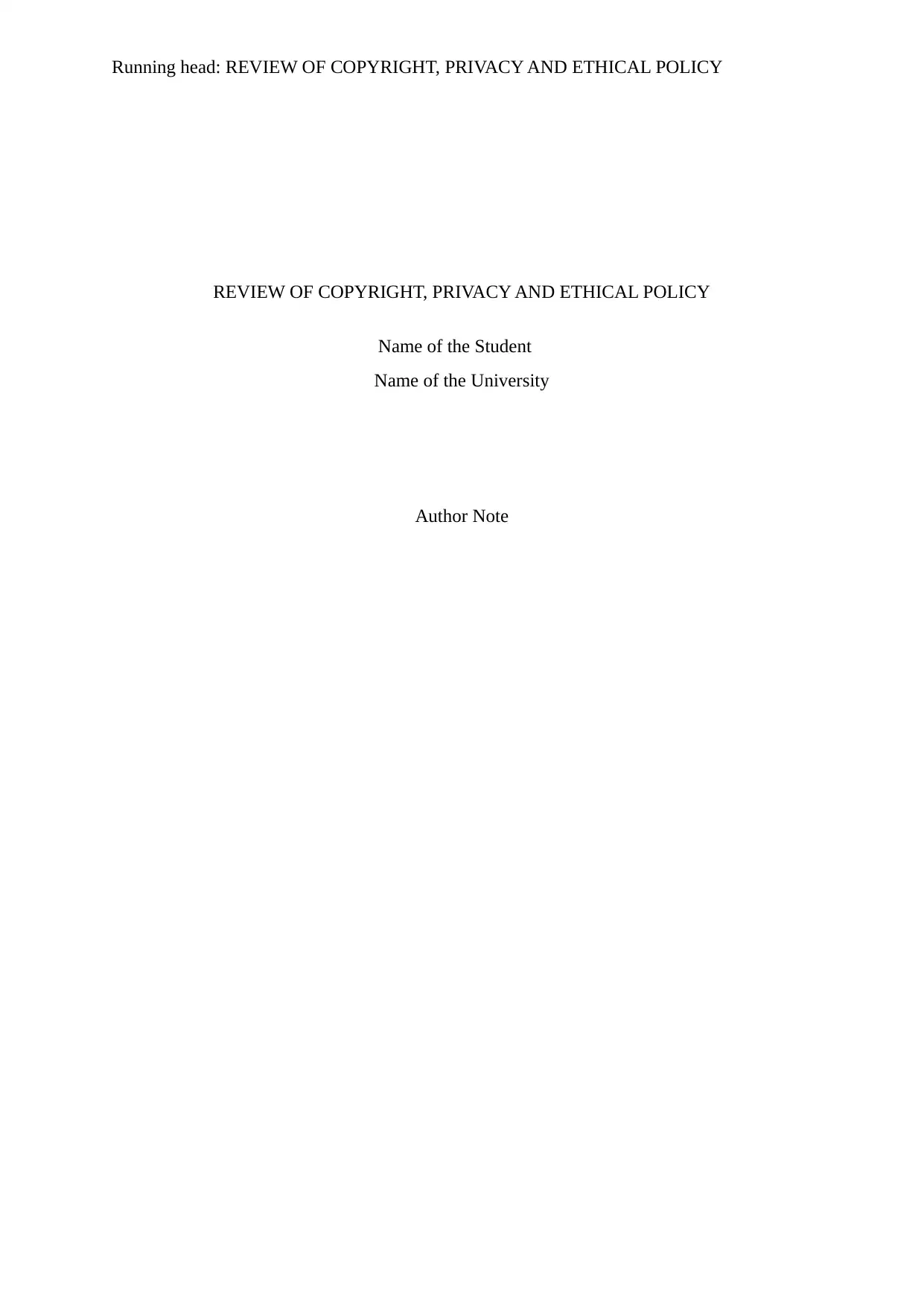
Running head: REVIEW OF COPYRIGHT, PRIVACY AND ETHICAL POLICY
REVIEW OF COPYRIGHT, PRIVACY AND ETHICAL POLICY
Name of the Student
Name of the University
Author Note
REVIEW OF COPYRIGHT, PRIVACY AND ETHICAL POLICY
Name of the Student
Name of the University
Author Note
Paraphrase This Document
Need a fresh take? Get an instant paraphrase of this document with our AI Paraphraser
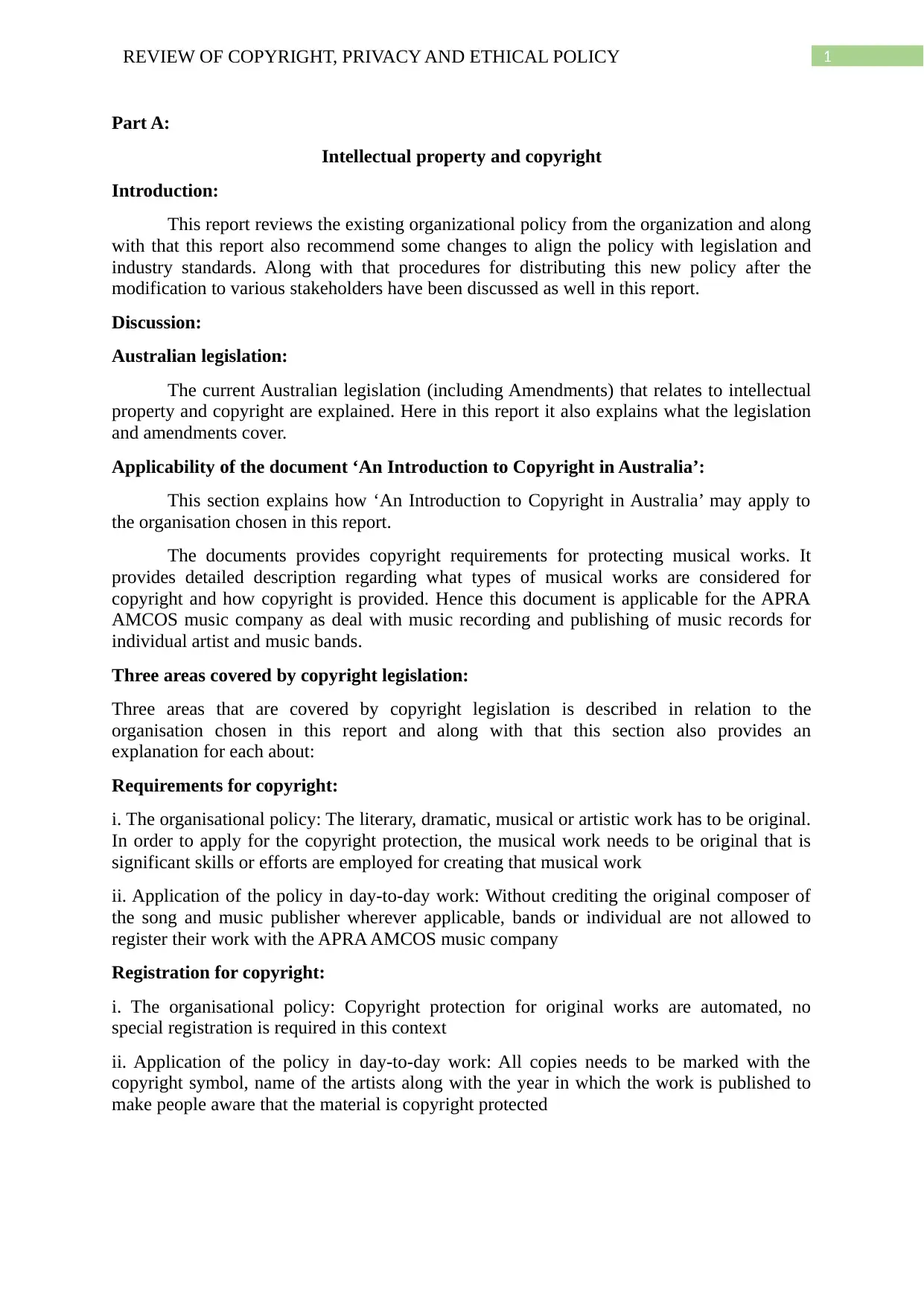
1REVIEW OF COPYRIGHT, PRIVACY AND ETHICAL POLICY
Part A:
Intellectual property and copyright
Introduction:
This report reviews the existing organizational policy from the organization and along
with that this report also recommend some changes to align the policy with legislation and
industry standards. Along with that procedures for distributing this new policy after the
modification to various stakeholders have been discussed as well in this report.
Discussion:
Australian legislation:
The current Australian legislation (including Amendments) that relates to intellectual
property and copyright are explained. Here in this report it also explains what the legislation
and amendments cover.
Applicability of the document ‘An Introduction to Copyright in Australia’:
This section explains how ‘An Introduction to Copyright in Australia’ may apply to
the organisation chosen in this report.
The documents provides copyright requirements for protecting musical works. It
provides detailed description regarding what types of musical works are considered for
copyright and how copyright is provided. Hence this document is applicable for the APRA
AMCOS music company as deal with music recording and publishing of music records for
individual artist and music bands.
Three areas covered by copyright legislation:
Three areas that are covered by copyright legislation is described in relation to the
organisation chosen in this report and along with that this section also provides an
explanation for each about:
Requirements for copyright:
i. The organisational policy: The literary, dramatic, musical or artistic work has to be original.
In order to apply for the copyright protection, the musical work needs to be original that is
significant skills or efforts are employed for creating that musical work
ii. Application of the policy in day-to-day work: Without crediting the original composer of
the song and music publisher wherever applicable, bands or individual are not allowed to
register their work with the APRA AMCOS music company
Registration for copyright:
i. The organisational policy: Copyright protection for original works are automated, no
special registration is required in this context
ii. Application of the policy in day-to-day work: All copies needs to be marked with the
copyright symbol, name of the artists along with the year in which the work is published to
make people aware that the material is copyright protected
Part A:
Intellectual property and copyright
Introduction:
This report reviews the existing organizational policy from the organization and along
with that this report also recommend some changes to align the policy with legislation and
industry standards. Along with that procedures for distributing this new policy after the
modification to various stakeholders have been discussed as well in this report.
Discussion:
Australian legislation:
The current Australian legislation (including Amendments) that relates to intellectual
property and copyright are explained. Here in this report it also explains what the legislation
and amendments cover.
Applicability of the document ‘An Introduction to Copyright in Australia’:
This section explains how ‘An Introduction to Copyright in Australia’ may apply to
the organisation chosen in this report.
The documents provides copyright requirements for protecting musical works. It
provides detailed description regarding what types of musical works are considered for
copyright and how copyright is provided. Hence this document is applicable for the APRA
AMCOS music company as deal with music recording and publishing of music records for
individual artist and music bands.
Three areas covered by copyright legislation:
Three areas that are covered by copyright legislation is described in relation to the
organisation chosen in this report and along with that this section also provides an
explanation for each about:
Requirements for copyright:
i. The organisational policy: The literary, dramatic, musical or artistic work has to be original.
In order to apply for the copyright protection, the musical work needs to be original that is
significant skills or efforts are employed for creating that musical work
ii. Application of the policy in day-to-day work: Without crediting the original composer of
the song and music publisher wherever applicable, bands or individual are not allowed to
register their work with the APRA AMCOS music company
Registration for copyright:
i. The organisational policy: Copyright protection for original works are automated, no
special registration is required in this context
ii. Application of the policy in day-to-day work: All copies needs to be marked with the
copyright symbol, name of the artists along with the year in which the work is published to
make people aware that the material is copyright protected
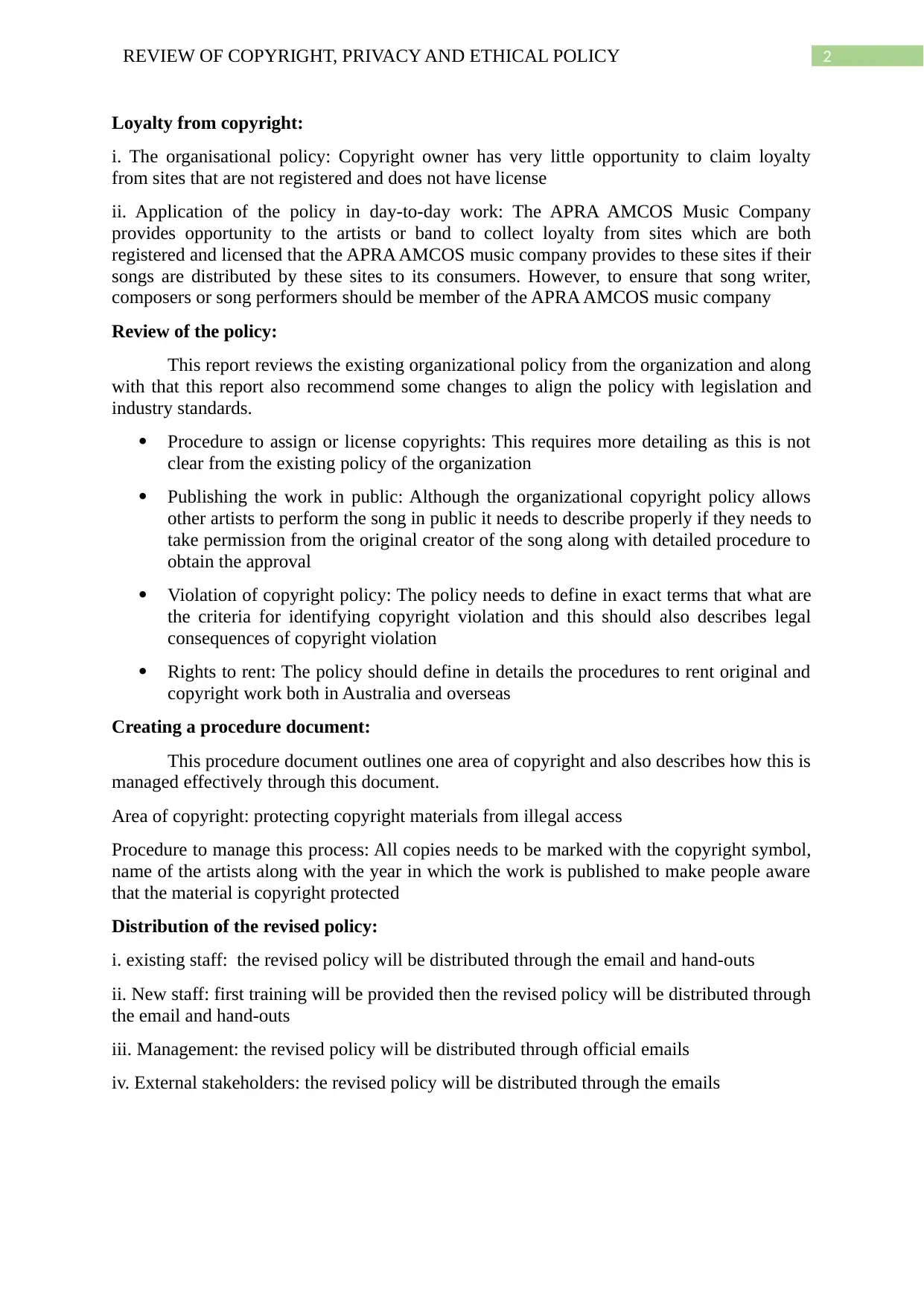
2REVIEW OF COPYRIGHT, PRIVACY AND ETHICAL POLICY
Loyalty from copyright:
i. The organisational policy: Copyright owner has very little opportunity to claim loyalty
from sites that are not registered and does not have license
ii. Application of the policy in day-to-day work: The APRA AMCOS Music Company
provides opportunity to the artists or band to collect loyalty from sites which are both
registered and licensed that the APRA AMCOS music company provides to these sites if their
songs are distributed by these sites to its consumers. However, to ensure that song writer,
composers or song performers should be member of the APRA AMCOS music company
Review of the policy:
This report reviews the existing organizational policy from the organization and along
with that this report also recommend some changes to align the policy with legislation and
industry standards.
Procedure to assign or license copyrights: This requires more detailing as this is not
clear from the existing policy of the organization
Publishing the work in public: Although the organizational copyright policy allows
other artists to perform the song in public it needs to describe properly if they needs to
take permission from the original creator of the song along with detailed procedure to
obtain the approval
Violation of copyright policy: The policy needs to define in exact terms that what are
the criteria for identifying copyright violation and this should also describes legal
consequences of copyright violation
Rights to rent: The policy should define in details the procedures to rent original and
copyright work both in Australia and overseas
Creating a procedure document:
This procedure document outlines one area of copyright and also describes how this is
managed effectively through this document.
Area of copyright: protecting copyright materials from illegal access
Procedure to manage this process: All copies needs to be marked with the copyright symbol,
name of the artists along with the year in which the work is published to make people aware
that the material is copyright protected
Distribution of the revised policy:
i. existing staff: the revised policy will be distributed through the email and hand-outs
ii. New staff: first training will be provided then the revised policy will be distributed through
the email and hand-outs
iii. Management: the revised policy will be distributed through official emails
iv. External stakeholders: the revised policy will be distributed through the emails
Loyalty from copyright:
i. The organisational policy: Copyright owner has very little opportunity to claim loyalty
from sites that are not registered and does not have license
ii. Application of the policy in day-to-day work: The APRA AMCOS Music Company
provides opportunity to the artists or band to collect loyalty from sites which are both
registered and licensed that the APRA AMCOS music company provides to these sites if their
songs are distributed by these sites to its consumers. However, to ensure that song writer,
composers or song performers should be member of the APRA AMCOS music company
Review of the policy:
This report reviews the existing organizational policy from the organization and along
with that this report also recommend some changes to align the policy with legislation and
industry standards.
Procedure to assign or license copyrights: This requires more detailing as this is not
clear from the existing policy of the organization
Publishing the work in public: Although the organizational copyright policy allows
other artists to perform the song in public it needs to describe properly if they needs to
take permission from the original creator of the song along with detailed procedure to
obtain the approval
Violation of copyright policy: The policy needs to define in exact terms that what are
the criteria for identifying copyright violation and this should also describes legal
consequences of copyright violation
Rights to rent: The policy should define in details the procedures to rent original and
copyright work both in Australia and overseas
Creating a procedure document:
This procedure document outlines one area of copyright and also describes how this is
managed effectively through this document.
Area of copyright: protecting copyright materials from illegal access
Procedure to manage this process: All copies needs to be marked with the copyright symbol,
name of the artists along with the year in which the work is published to make people aware
that the material is copyright protected
Distribution of the revised policy:
i. existing staff: the revised policy will be distributed through the email and hand-outs
ii. New staff: first training will be provided then the revised policy will be distributed through
the email and hand-outs
iii. Management: the revised policy will be distributed through official emails
iv. External stakeholders: the revised policy will be distributed through the emails
⊘ This is a preview!⊘
Do you want full access?
Subscribe today to unlock all pages.

Trusted by 1+ million students worldwide
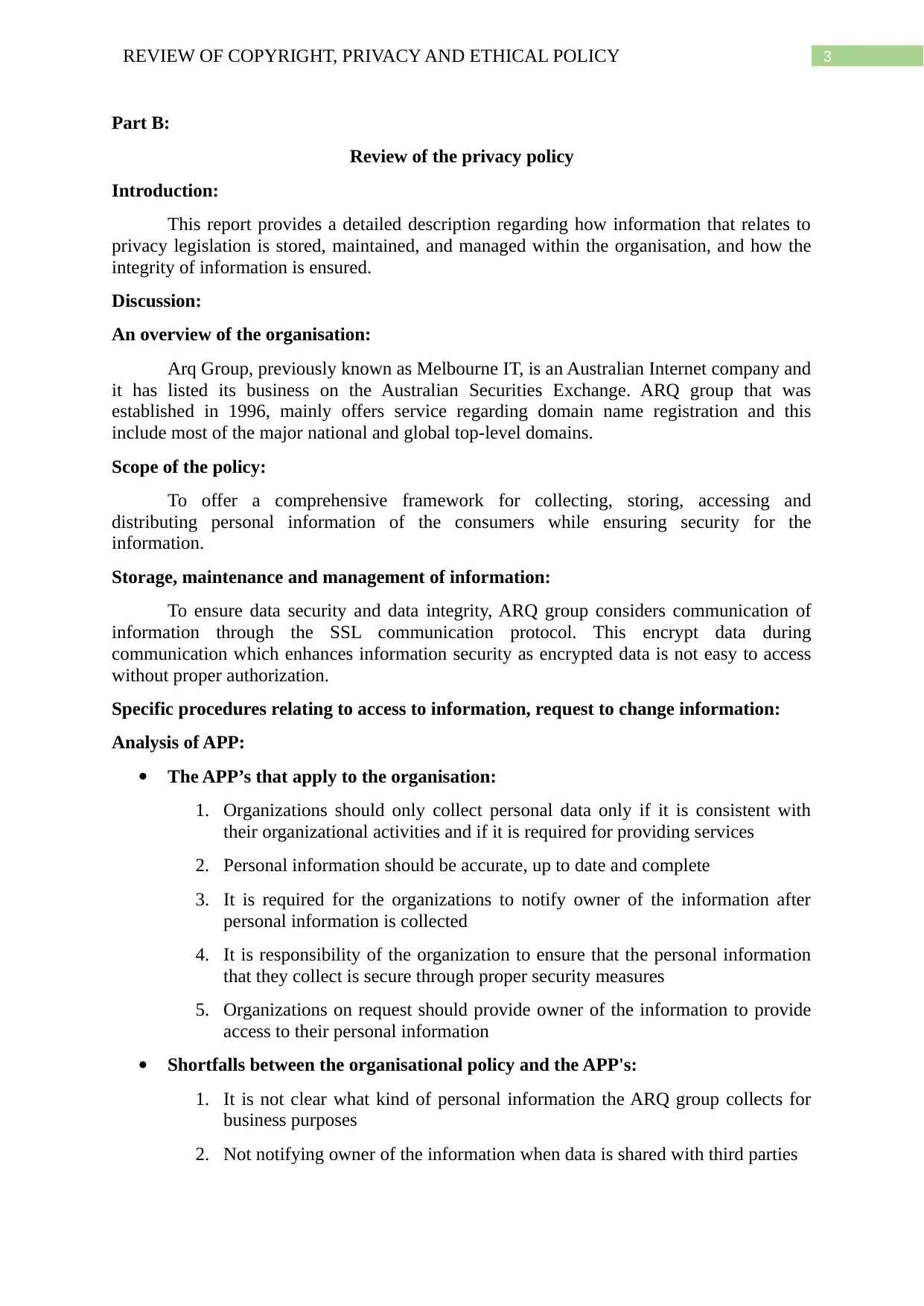
3REVIEW OF COPYRIGHT, PRIVACY AND ETHICAL POLICY
Part B:
Review of the privacy policy
Introduction:
This report provides a detailed description regarding how information that relates to
privacy legislation is stored, maintained, and managed within the organisation, and how the
integrity of information is ensured.
Discussion:
An overview of the organisation:
Arq Group, previously known as Melbourne IT, is an Australian Internet company and
it has listed its business on the Australian Securities Exchange. ARQ group that was
established in 1996, mainly offers service regarding domain name registration and this
include most of the major national and global top-level domains.
Scope of the policy:
To offer a comprehensive framework for collecting, storing, accessing and
distributing personal information of the consumers while ensuring security for the
information.
Storage, maintenance and management of information:
To ensure data security and data integrity, ARQ group considers communication of
information through the SSL communication protocol. This encrypt data during
communication which enhances information security as encrypted data is not easy to access
without proper authorization.
Specific procedures relating to access to information, request to change information:
Analysis of APP:
The APP’s that apply to the organisation:
1. Organizations should only collect personal data only if it is consistent with
their organizational activities and if it is required for providing services
2. Personal information should be accurate, up to date and complete
3. It is required for the organizations to notify owner of the information after
personal information is collected
4. It is responsibility of the organization to ensure that the personal information
that they collect is secure through proper security measures
5. Organizations on request should provide owner of the information to provide
access to their personal information
Shortfalls between the organisational policy and the APP's:
1. It is not clear what kind of personal information the ARQ group collects for
business purposes
2. Not notifying owner of the information when data is shared with third parties
Part B:
Review of the privacy policy
Introduction:
This report provides a detailed description regarding how information that relates to
privacy legislation is stored, maintained, and managed within the organisation, and how the
integrity of information is ensured.
Discussion:
An overview of the organisation:
Arq Group, previously known as Melbourne IT, is an Australian Internet company and
it has listed its business on the Australian Securities Exchange. ARQ group that was
established in 1996, mainly offers service regarding domain name registration and this
include most of the major national and global top-level domains.
Scope of the policy:
To offer a comprehensive framework for collecting, storing, accessing and
distributing personal information of the consumers while ensuring security for the
information.
Storage, maintenance and management of information:
To ensure data security and data integrity, ARQ group considers communication of
information through the SSL communication protocol. This encrypt data during
communication which enhances information security as encrypted data is not easy to access
without proper authorization.
Specific procedures relating to access to information, request to change information:
Analysis of APP:
The APP’s that apply to the organisation:
1. Organizations should only collect personal data only if it is consistent with
their organizational activities and if it is required for providing services
2. Personal information should be accurate, up to date and complete
3. It is required for the organizations to notify owner of the information after
personal information is collected
4. It is responsibility of the organization to ensure that the personal information
that they collect is secure through proper security measures
5. Organizations on request should provide owner of the information to provide
access to their personal information
Shortfalls between the organisational policy and the APP's:
1. It is not clear what kind of personal information the ARQ group collects for
business purposes
2. Not notifying owner of the information when data is shared with third parties
Paraphrase This Document
Need a fresh take? Get an instant paraphrase of this document with our AI Paraphraser
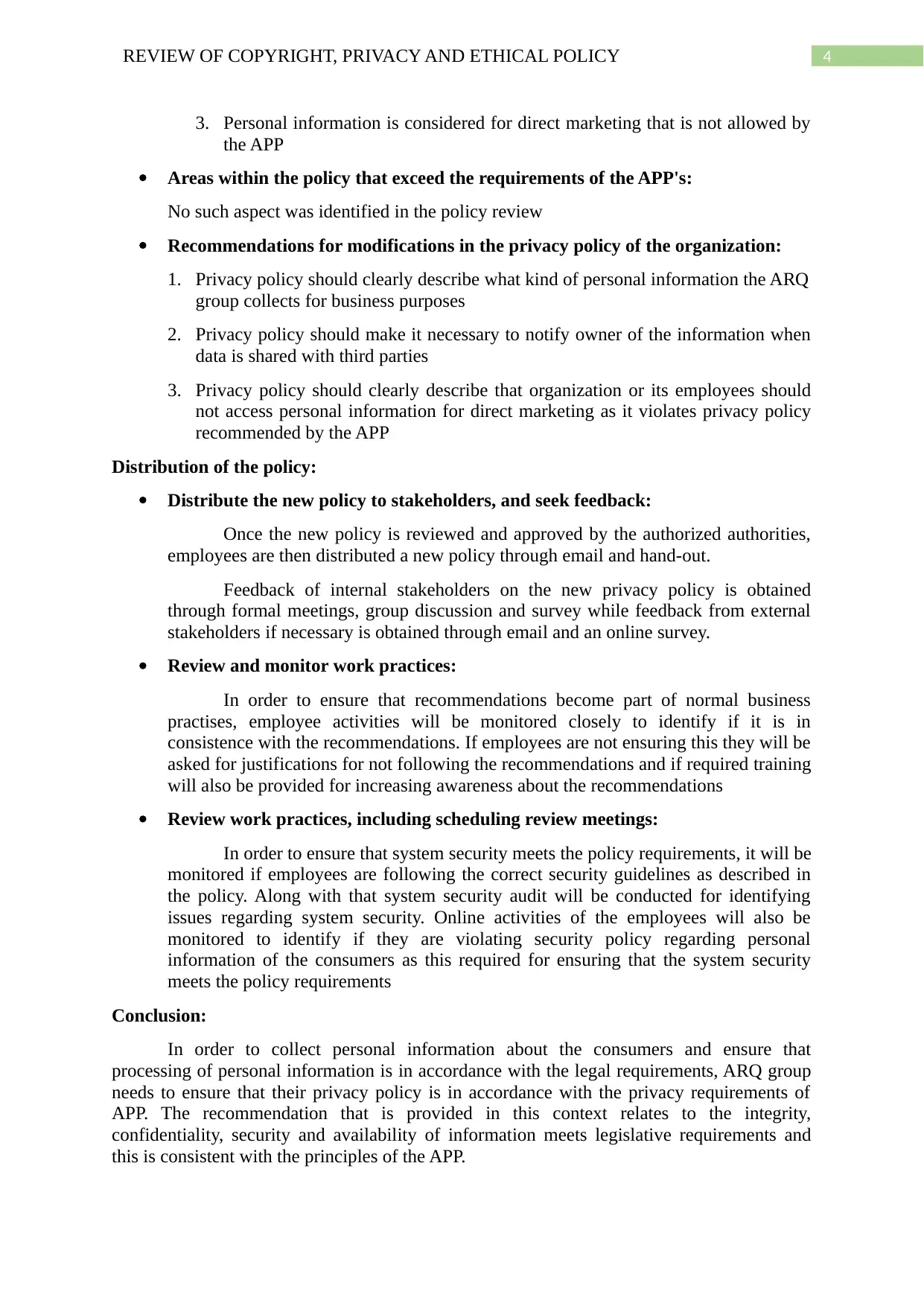
4REVIEW OF COPYRIGHT, PRIVACY AND ETHICAL POLICY
3. Personal information is considered for direct marketing that is not allowed by
the APP
Areas within the policy that exceed the requirements of the APP's:
No such aspect was identified in the policy review
Recommendations for modifications in the privacy policy of the organization:
1. Privacy policy should clearly describe what kind of personal information the ARQ
group collects for business purposes
2. Privacy policy should make it necessary to notify owner of the information when
data is shared with third parties
3. Privacy policy should clearly describe that organization or its employees should
not access personal information for direct marketing as it violates privacy policy
recommended by the APP
Distribution of the policy:
Distribute the new policy to stakeholders, and seek feedback:
Once the new policy is reviewed and approved by the authorized authorities,
employees are then distributed a new policy through email and hand-out.
Feedback of internal stakeholders on the new privacy policy is obtained
through formal meetings, group discussion and survey while feedback from external
stakeholders if necessary is obtained through email and an online survey.
Review and monitor work practices:
In order to ensure that recommendations become part of normal business
practises, employee activities will be monitored closely to identify if it is in
consistence with the recommendations. If employees are not ensuring this they will be
asked for justifications for not following the recommendations and if required training
will also be provided for increasing awareness about the recommendations
Review work practices, including scheduling review meetings:
In order to ensure that system security meets the policy requirements, it will be
monitored if employees are following the correct security guidelines as described in
the policy. Along with that system security audit will be conducted for identifying
issues regarding system security. Online activities of the employees will also be
monitored to identify if they are violating security policy regarding personal
information of the consumers as this required for ensuring that the system security
meets the policy requirements
Conclusion:
In order to collect personal information about the consumers and ensure that
processing of personal information is in accordance with the legal requirements, ARQ group
needs to ensure that their privacy policy is in accordance with the privacy requirements of
APP. The recommendation that is provided in this context relates to the integrity,
confidentiality, security and availability of information meets legislative requirements and
this is consistent with the principles of the APP.
3. Personal information is considered for direct marketing that is not allowed by
the APP
Areas within the policy that exceed the requirements of the APP's:
No such aspect was identified in the policy review
Recommendations for modifications in the privacy policy of the organization:
1. Privacy policy should clearly describe what kind of personal information the ARQ
group collects for business purposes
2. Privacy policy should make it necessary to notify owner of the information when
data is shared with third parties
3. Privacy policy should clearly describe that organization or its employees should
not access personal information for direct marketing as it violates privacy policy
recommended by the APP
Distribution of the policy:
Distribute the new policy to stakeholders, and seek feedback:
Once the new policy is reviewed and approved by the authorized authorities,
employees are then distributed a new policy through email and hand-out.
Feedback of internal stakeholders on the new privacy policy is obtained
through formal meetings, group discussion and survey while feedback from external
stakeholders if necessary is obtained through email and an online survey.
Review and monitor work practices:
In order to ensure that recommendations become part of normal business
practises, employee activities will be monitored closely to identify if it is in
consistence with the recommendations. If employees are not ensuring this they will be
asked for justifications for not following the recommendations and if required training
will also be provided for increasing awareness about the recommendations
Review work practices, including scheduling review meetings:
In order to ensure that system security meets the policy requirements, it will be
monitored if employees are following the correct security guidelines as described in
the policy. Along with that system security audit will be conducted for identifying
issues regarding system security. Online activities of the employees will also be
monitored to identify if they are violating security policy regarding personal
information of the consumers as this required for ensuring that the system security
meets the policy requirements
Conclusion:
In order to collect personal information about the consumers and ensure that
processing of personal information is in accordance with the legal requirements, ARQ group
needs to ensure that their privacy policy is in accordance with the privacy requirements of
APP. The recommendation that is provided in this context relates to the integrity,
confidentiality, security and availability of information meets legislative requirements and
this is consistent with the principles of the APP.
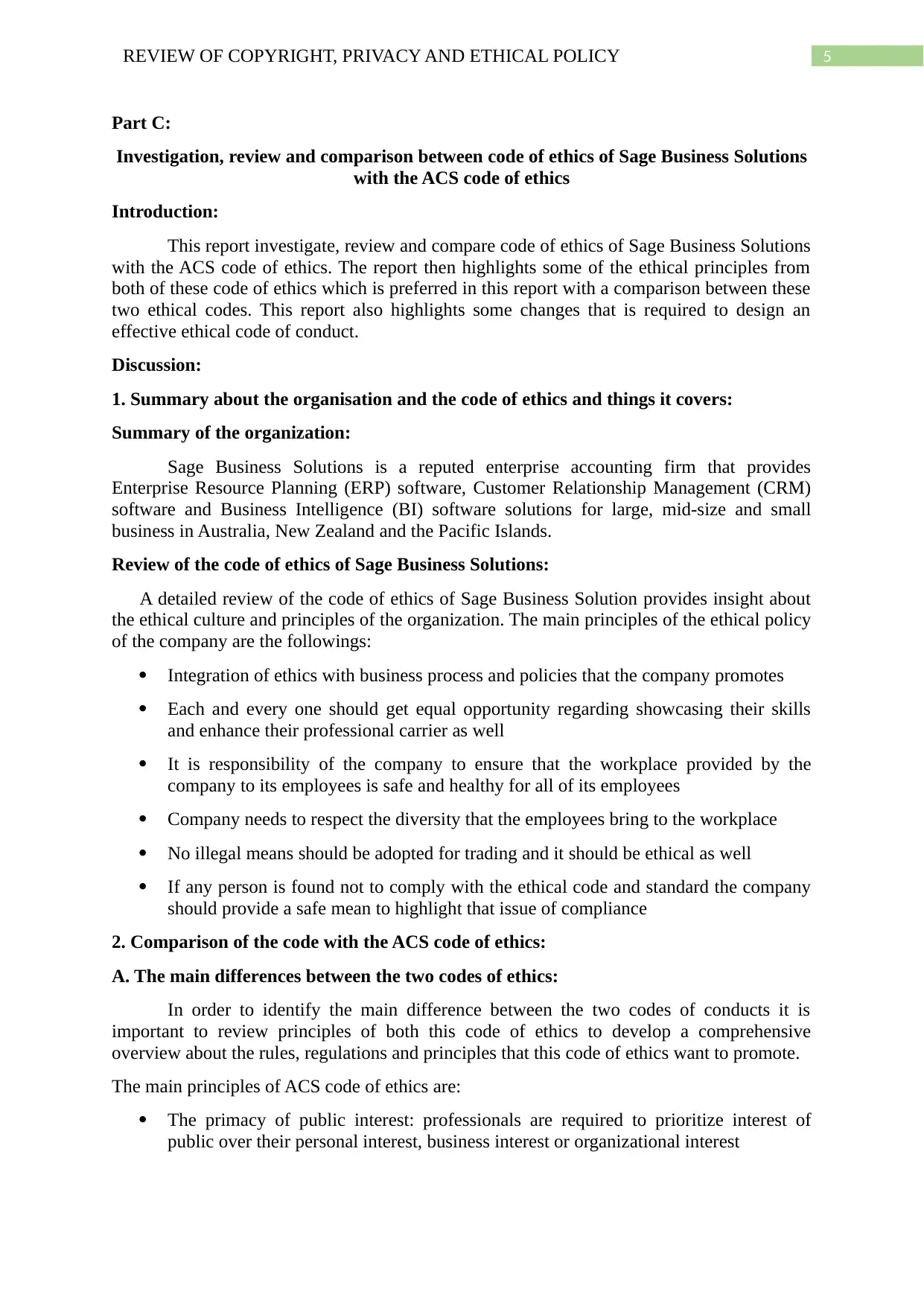
5REVIEW OF COPYRIGHT, PRIVACY AND ETHICAL POLICY
Part C:
Investigation, review and comparison between code of ethics of Sage Business Solutions
with the ACS code of ethics
Introduction:
This report investigate, review and compare code of ethics of Sage Business Solutions
with the ACS code of ethics. The report then highlights some of the ethical principles from
both of these code of ethics which is preferred in this report with a comparison between these
two ethical codes. This report also highlights some changes that is required to design an
effective ethical code of conduct.
Discussion:
1. Summary about the organisation and the code of ethics and things it covers:
Summary of the organization:
Sage Business Solutions is a reputed enterprise accounting firm that provides
Enterprise Resource Planning (ERP) software, Customer Relationship Management (CRM)
software and Business Intelligence (BI) software solutions for large, mid-size and small
business in Australia, New Zealand and the Pacific Islands.
Review of the code of ethics of Sage Business Solutions:
A detailed review of the code of ethics of Sage Business Solution provides insight about
the ethical culture and principles of the organization. The main principles of the ethical policy
of the company are the followings:
Integration of ethics with business process and policies that the company promotes
Each and every one should get equal opportunity regarding showcasing their skills
and enhance their professional carrier as well
It is responsibility of the company to ensure that the workplace provided by the
company to its employees is safe and healthy for all of its employees
Company needs to respect the diversity that the employees bring to the workplace
No illegal means should be adopted for trading and it should be ethical as well
If any person is found not to comply with the ethical code and standard the company
should provide a safe mean to highlight that issue of compliance
2. Comparison of the code with the ACS code of ethics:
A. The main differences between the two codes of ethics:
In order to identify the main difference between the two codes of conducts it is
important to review principles of both this code of ethics to develop a comprehensive
overview about the rules, regulations and principles that this code of ethics want to promote.
The main principles of ACS code of ethics are:
The primacy of public interest: professionals are required to prioritize interest of
public over their personal interest, business interest or organizational interest
Part C:
Investigation, review and comparison between code of ethics of Sage Business Solutions
with the ACS code of ethics
Introduction:
This report investigate, review and compare code of ethics of Sage Business Solutions
with the ACS code of ethics. The report then highlights some of the ethical principles from
both of these code of ethics which is preferred in this report with a comparison between these
two ethical codes. This report also highlights some changes that is required to design an
effective ethical code of conduct.
Discussion:
1. Summary about the organisation and the code of ethics and things it covers:
Summary of the organization:
Sage Business Solutions is a reputed enterprise accounting firm that provides
Enterprise Resource Planning (ERP) software, Customer Relationship Management (CRM)
software and Business Intelligence (BI) software solutions for large, mid-size and small
business in Australia, New Zealand and the Pacific Islands.
Review of the code of ethics of Sage Business Solutions:
A detailed review of the code of ethics of Sage Business Solution provides insight about
the ethical culture and principles of the organization. The main principles of the ethical policy
of the company are the followings:
Integration of ethics with business process and policies that the company promotes
Each and every one should get equal opportunity regarding showcasing their skills
and enhance their professional carrier as well
It is responsibility of the company to ensure that the workplace provided by the
company to its employees is safe and healthy for all of its employees
Company needs to respect the diversity that the employees bring to the workplace
No illegal means should be adopted for trading and it should be ethical as well
If any person is found not to comply with the ethical code and standard the company
should provide a safe mean to highlight that issue of compliance
2. Comparison of the code with the ACS code of ethics:
A. The main differences between the two codes of ethics:
In order to identify the main difference between the two codes of conducts it is
important to review principles of both this code of ethics to develop a comprehensive
overview about the rules, regulations and principles that this code of ethics want to promote.
The main principles of ACS code of ethics are:
The primacy of public interest: professionals are required to prioritize interest of
public over their personal interest, business interest or organizational interest
⊘ This is a preview!⊘
Do you want full access?
Subscribe today to unlock all pages.

Trusted by 1+ million students worldwide
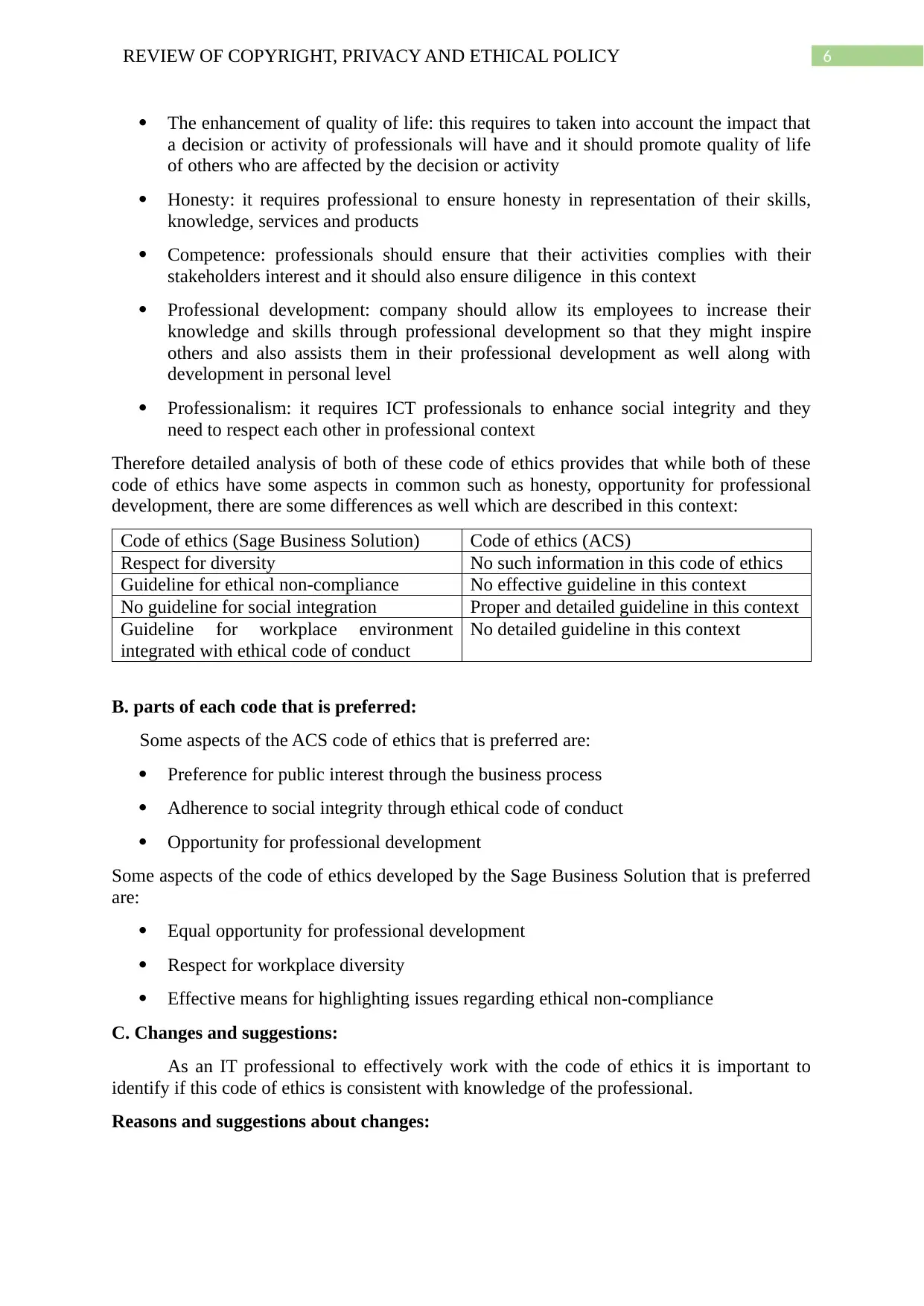
6REVIEW OF COPYRIGHT, PRIVACY AND ETHICAL POLICY
The enhancement of quality of life: this requires to taken into account the impact that
a decision or activity of professionals will have and it should promote quality of life
of others who are affected by the decision or activity
Honesty: it requires professional to ensure honesty in representation of their skills,
knowledge, services and products
Competence: professionals should ensure that their activities complies with their
stakeholders interest and it should also ensure diligence in this context
Professional development: company should allow its employees to increase their
knowledge and skills through professional development so that they might inspire
others and also assists them in their professional development as well along with
development in personal level
Professionalism: it requires ICT professionals to enhance social integrity and they
need to respect each other in professional context
Therefore detailed analysis of both of these code of ethics provides that while both of these
code of ethics have some aspects in common such as honesty, opportunity for professional
development, there are some differences as well which are described in this context:
Code of ethics (Sage Business Solution) Code of ethics (ACS)
Respect for diversity No such information in this code of ethics
Guideline for ethical non-compliance No effective guideline in this context
No guideline for social integration Proper and detailed guideline in this context
Guideline for workplace environment
integrated with ethical code of conduct
No detailed guideline in this context
B. parts of each code that is preferred:
Some aspects of the ACS code of ethics that is preferred are:
Preference for public interest through the business process
Adherence to social integrity through ethical code of conduct
Opportunity for professional development
Some aspects of the code of ethics developed by the Sage Business Solution that is preferred
are:
Equal opportunity for professional development
Respect for workplace diversity
Effective means for highlighting issues regarding ethical non-compliance
C. Changes and suggestions:
As an IT professional to effectively work with the code of ethics it is important to
identify if this code of ethics is consistent with knowledge of the professional.
Reasons and suggestions about changes:
The enhancement of quality of life: this requires to taken into account the impact that
a decision or activity of professionals will have and it should promote quality of life
of others who are affected by the decision or activity
Honesty: it requires professional to ensure honesty in representation of their skills,
knowledge, services and products
Competence: professionals should ensure that their activities complies with their
stakeholders interest and it should also ensure diligence in this context
Professional development: company should allow its employees to increase their
knowledge and skills through professional development so that they might inspire
others and also assists them in their professional development as well along with
development in personal level
Professionalism: it requires ICT professionals to enhance social integrity and they
need to respect each other in professional context
Therefore detailed analysis of both of these code of ethics provides that while both of these
code of ethics have some aspects in common such as honesty, opportunity for professional
development, there are some differences as well which are described in this context:
Code of ethics (Sage Business Solution) Code of ethics (ACS)
Respect for diversity No such information in this code of ethics
Guideline for ethical non-compliance No effective guideline in this context
No guideline for social integration Proper and detailed guideline in this context
Guideline for workplace environment
integrated with ethical code of conduct
No detailed guideline in this context
B. parts of each code that is preferred:
Some aspects of the ACS code of ethics that is preferred are:
Preference for public interest through the business process
Adherence to social integrity through ethical code of conduct
Opportunity for professional development
Some aspects of the code of ethics developed by the Sage Business Solution that is preferred
are:
Equal opportunity for professional development
Respect for workplace diversity
Effective means for highlighting issues regarding ethical non-compliance
C. Changes and suggestions:
As an IT professional to effectively work with the code of ethics it is important to
identify if this code of ethics is consistent with knowledge of the professional.
Reasons and suggestions about changes:
Paraphrase This Document
Need a fresh take? Get an instant paraphrase of this document with our AI Paraphraser
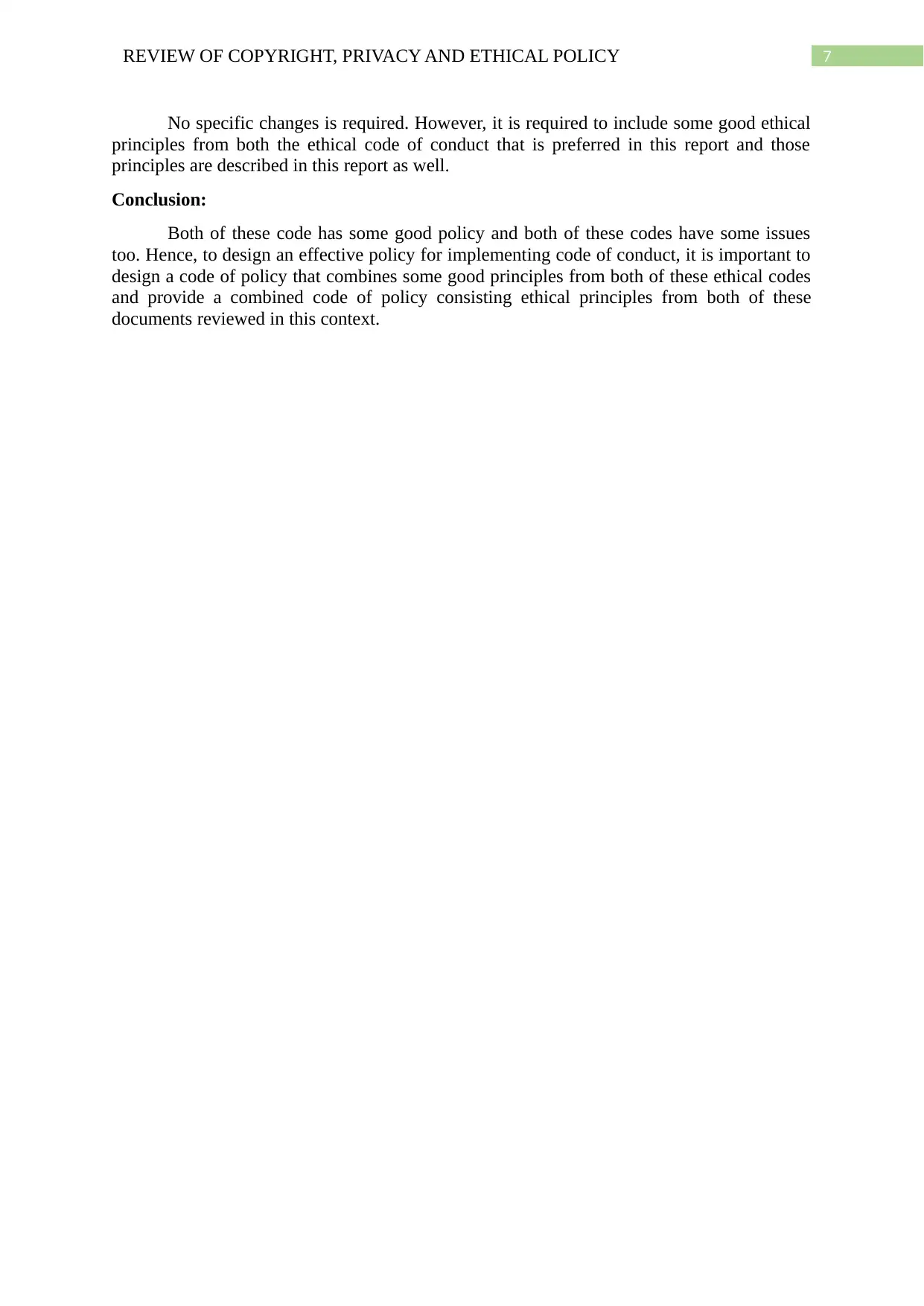
7REVIEW OF COPYRIGHT, PRIVACY AND ETHICAL POLICY
No specific changes is required. However, it is required to include some good ethical
principles from both the ethical code of conduct that is preferred in this report and those
principles are described in this report as well.
Conclusion:
Both of these code has some good policy and both of these codes have some issues
too. Hence, to design an effective policy for implementing code of conduct, it is important to
design a code of policy that combines some good principles from both of these ethical codes
and provide a combined code of policy consisting ethical principles from both of these
documents reviewed in this context.
No specific changes is required. However, it is required to include some good ethical
principles from both the ethical code of conduct that is preferred in this report and those
principles are described in this report as well.
Conclusion:
Both of these code has some good policy and both of these codes have some issues
too. Hence, to design an effective policy for implementing code of conduct, it is important to
design a code of policy that combines some good principles from both of these ethical codes
and provide a combined code of policy consisting ethical principles from both of these
documents reviewed in this context.
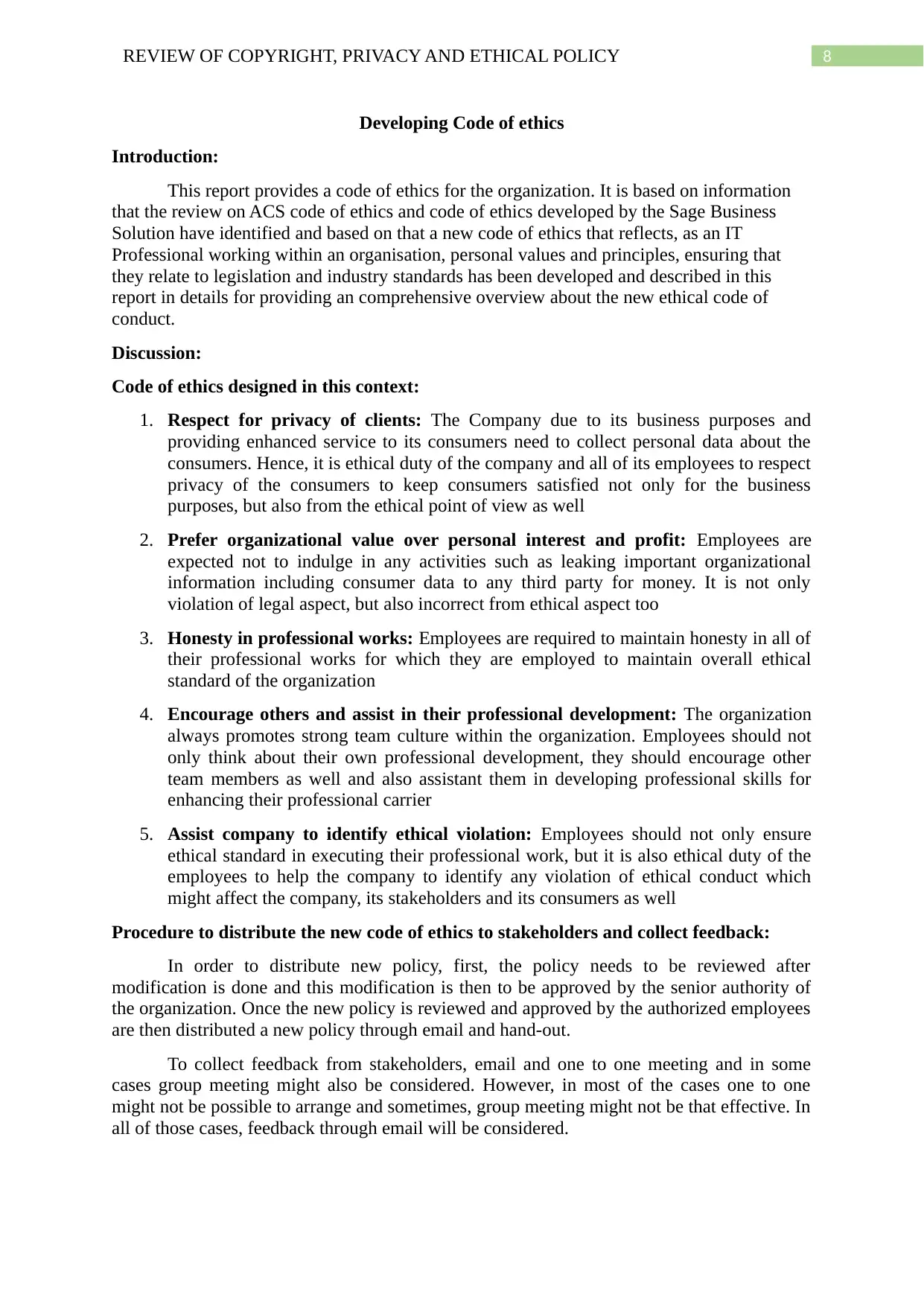
8REVIEW OF COPYRIGHT, PRIVACY AND ETHICAL POLICY
Developing Code of ethics
Introduction:
This report provides a code of ethics for the organization. It is based on information
that the review on ACS code of ethics and code of ethics developed by the Sage Business
Solution have identified and based on that a new code of ethics that reflects, as an IT
Professional working within an organisation, personal values and principles, ensuring that
they relate to legislation and industry standards has been developed and described in this
report in details for providing an comprehensive overview about the new ethical code of
conduct.
Discussion:
Code of ethics designed in this context:
1. Respect for privacy of clients: The Company due to its business purposes and
providing enhanced service to its consumers need to collect personal data about the
consumers. Hence, it is ethical duty of the company and all of its employees to respect
privacy of the consumers to keep consumers satisfied not only for the business
purposes, but also from the ethical point of view as well
2. Prefer organizational value over personal interest and profit: Employees are
expected not to indulge in any activities such as leaking important organizational
information including consumer data to any third party for money. It is not only
violation of legal aspect, but also incorrect from ethical aspect too
3. Honesty in professional works: Employees are required to maintain honesty in all of
their professional works for which they are employed to maintain overall ethical
standard of the organization
4. Encourage others and assist in their professional development: The organization
always promotes strong team culture within the organization. Employees should not
only think about their own professional development, they should encourage other
team members as well and also assistant them in developing professional skills for
enhancing their professional carrier
5. Assist company to identify ethical violation: Employees should not only ensure
ethical standard in executing their professional work, but it is also ethical duty of the
employees to help the company to identify any violation of ethical conduct which
might affect the company, its stakeholders and its consumers as well
Procedure to distribute the new code of ethics to stakeholders and collect feedback:
In order to distribute new policy, first, the policy needs to be reviewed after
modification is done and this modification is then to be approved by the senior authority of
the organization. Once the new policy is reviewed and approved by the authorized employees
are then distributed a new policy through email and hand-out.
To collect feedback from stakeholders, email and one to one meeting and in some
cases group meeting might also be considered. However, in most of the cases one to one
might not be possible to arrange and sometimes, group meeting might not be that effective. In
all of those cases, feedback through email will be considered.
Developing Code of ethics
Introduction:
This report provides a code of ethics for the organization. It is based on information
that the review on ACS code of ethics and code of ethics developed by the Sage Business
Solution have identified and based on that a new code of ethics that reflects, as an IT
Professional working within an organisation, personal values and principles, ensuring that
they relate to legislation and industry standards has been developed and described in this
report in details for providing an comprehensive overview about the new ethical code of
conduct.
Discussion:
Code of ethics designed in this context:
1. Respect for privacy of clients: The Company due to its business purposes and
providing enhanced service to its consumers need to collect personal data about the
consumers. Hence, it is ethical duty of the company and all of its employees to respect
privacy of the consumers to keep consumers satisfied not only for the business
purposes, but also from the ethical point of view as well
2. Prefer organizational value over personal interest and profit: Employees are
expected not to indulge in any activities such as leaking important organizational
information including consumer data to any third party for money. It is not only
violation of legal aspect, but also incorrect from ethical aspect too
3. Honesty in professional works: Employees are required to maintain honesty in all of
their professional works for which they are employed to maintain overall ethical
standard of the organization
4. Encourage others and assist in their professional development: The organization
always promotes strong team culture within the organization. Employees should not
only think about their own professional development, they should encourage other
team members as well and also assistant them in developing professional skills for
enhancing their professional carrier
5. Assist company to identify ethical violation: Employees should not only ensure
ethical standard in executing their professional work, but it is also ethical duty of the
employees to help the company to identify any violation of ethical conduct which
might affect the company, its stakeholders and its consumers as well
Procedure to distribute the new code of ethics to stakeholders and collect feedback:
In order to distribute new policy, first, the policy needs to be reviewed after
modification is done and this modification is then to be approved by the senior authority of
the organization. Once the new policy is reviewed and approved by the authorized employees
are then distributed a new policy through email and hand-out.
To collect feedback from stakeholders, email and one to one meeting and in some
cases group meeting might also be considered. However, in most of the cases one to one
might not be possible to arrange and sometimes, group meeting might not be that effective. In
all of those cases, feedback through email will be considered.
⊘ This is a preview!⊘
Do you want full access?
Subscribe today to unlock all pages.

Trusted by 1+ million students worldwide
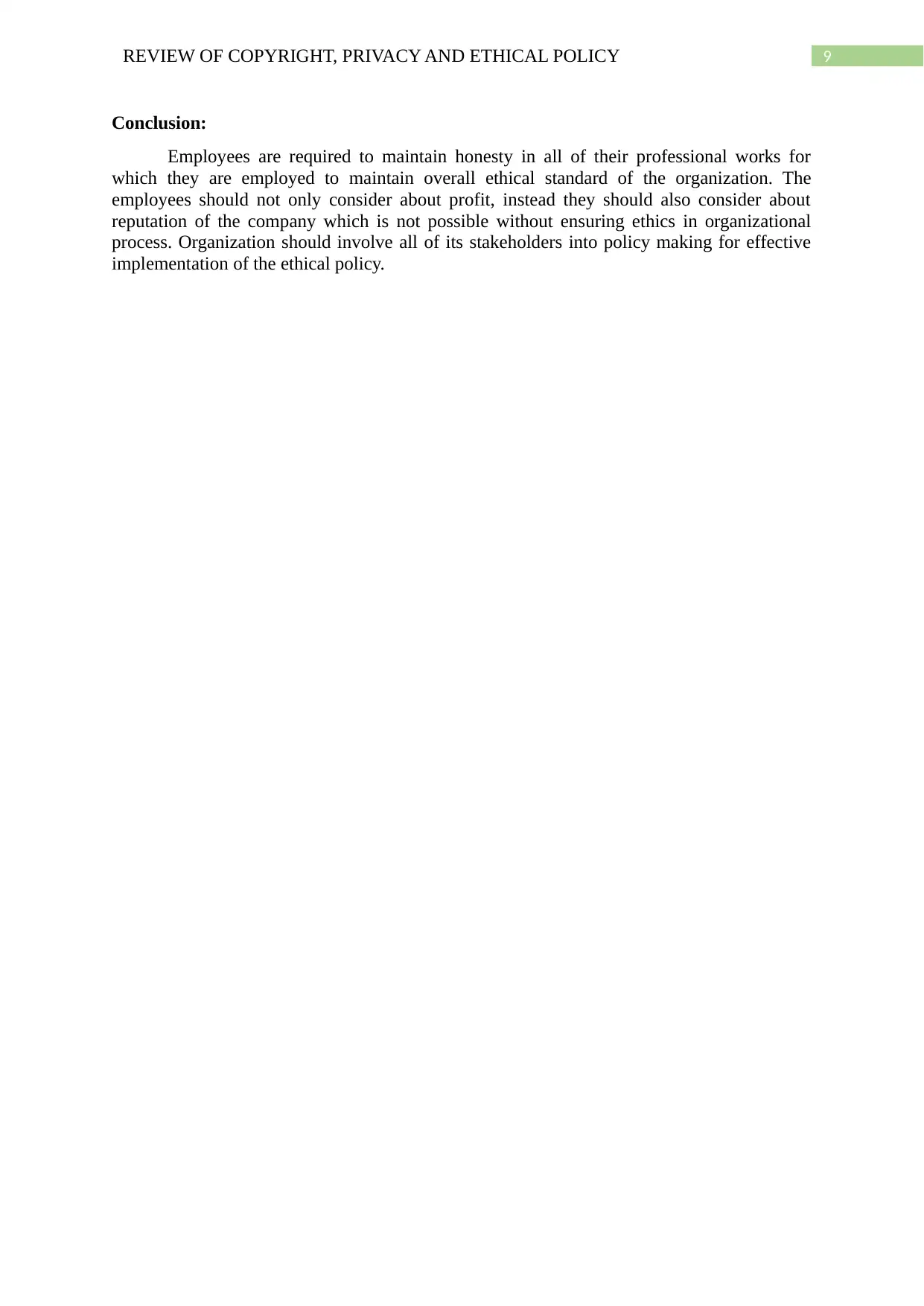
9REVIEW OF COPYRIGHT, PRIVACY AND ETHICAL POLICY
Conclusion:
Employees are required to maintain honesty in all of their professional works for
which they are employed to maintain overall ethical standard of the organization. The
employees should not only consider about profit, instead they should also consider about
reputation of the company which is not possible without ensuring ethics in organizational
process. Organization should involve all of its stakeholders into policy making for effective
implementation of the ethical policy.
Conclusion:
Employees are required to maintain honesty in all of their professional works for
which they are employed to maintain overall ethical standard of the organization. The
employees should not only consider about profit, instead they should also consider about
reputation of the company which is not possible without ensuring ethics in organizational
process. Organization should involve all of its stakeholders into policy making for effective
implementation of the ethical policy.
Paraphrase This Document
Need a fresh take? Get an instant paraphrase of this document with our AI Paraphraser
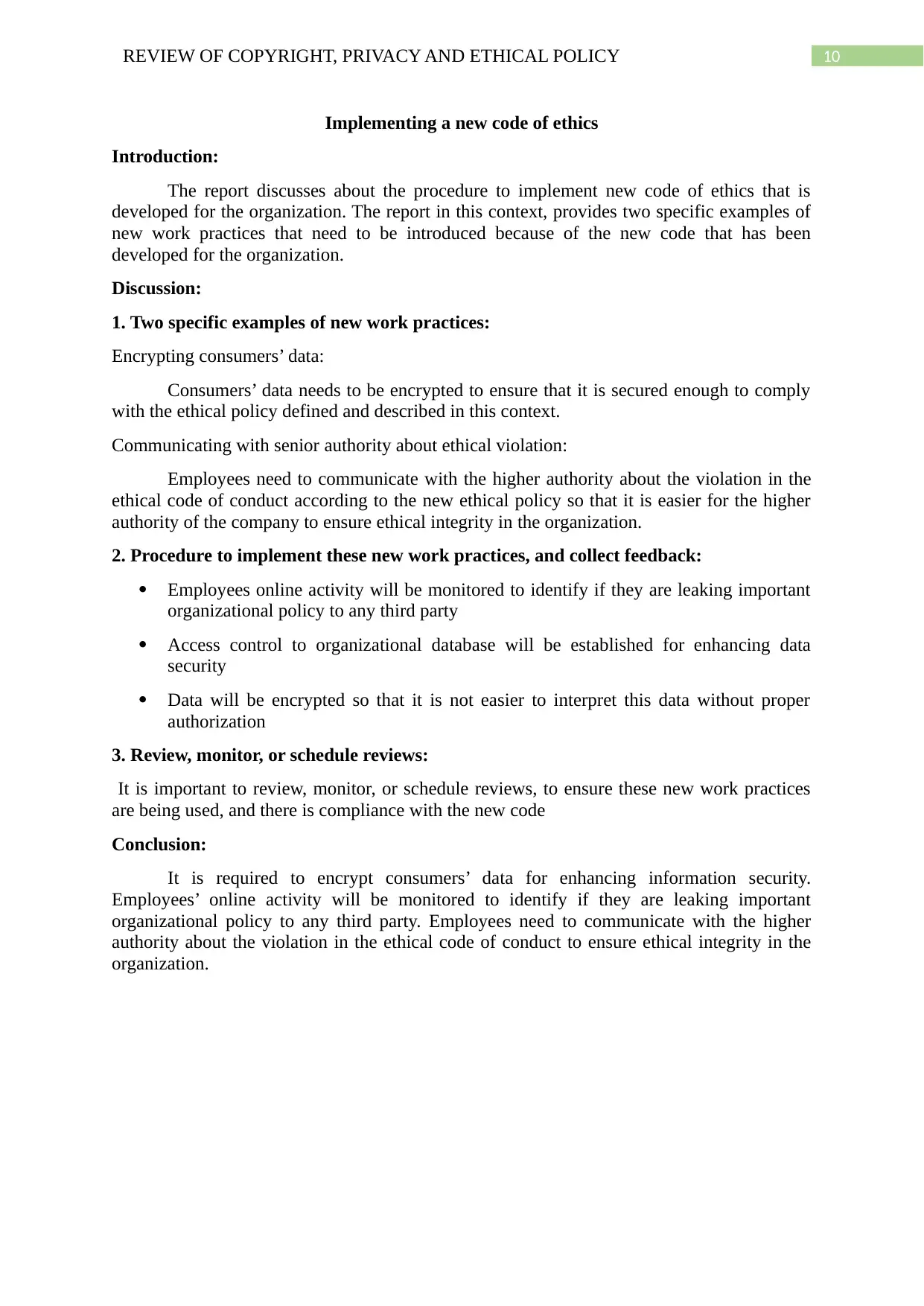
10REVIEW OF COPYRIGHT, PRIVACY AND ETHICAL POLICY
Implementing a new code of ethics
Introduction:
The report discusses about the procedure to implement new code of ethics that is
developed for the organization. The report in this context, provides two specific examples of
new work practices that need to be introduced because of the new code that has been
developed for the organization.
Discussion:
1. Two specific examples of new work practices:
Encrypting consumers’ data:
Consumers’ data needs to be encrypted to ensure that it is secured enough to comply
with the ethical policy defined and described in this context.
Communicating with senior authority about ethical violation:
Employees need to communicate with the higher authority about the violation in the
ethical code of conduct according to the new ethical policy so that it is easier for the higher
authority of the company to ensure ethical integrity in the organization.
2. Procedure to implement these new work practices, and collect feedback:
Employees online activity will be monitored to identify if they are leaking important
organizational policy to any third party
Access control to organizational database will be established for enhancing data
security
Data will be encrypted so that it is not easier to interpret this data without proper
authorization
3. Review, monitor, or schedule reviews:
It is important to review, monitor, or schedule reviews, to ensure these new work practices
are being used, and there is compliance with the new code
Conclusion:
It is required to encrypt consumers’ data for enhancing information security.
Employees’ online activity will be monitored to identify if they are leaking important
organizational policy to any third party. Employees need to communicate with the higher
authority about the violation in the ethical code of conduct to ensure ethical integrity in the
organization.
Implementing a new code of ethics
Introduction:
The report discusses about the procedure to implement new code of ethics that is
developed for the organization. The report in this context, provides two specific examples of
new work practices that need to be introduced because of the new code that has been
developed for the organization.
Discussion:
1. Two specific examples of new work practices:
Encrypting consumers’ data:
Consumers’ data needs to be encrypted to ensure that it is secured enough to comply
with the ethical policy defined and described in this context.
Communicating with senior authority about ethical violation:
Employees need to communicate with the higher authority about the violation in the
ethical code of conduct according to the new ethical policy so that it is easier for the higher
authority of the company to ensure ethical integrity in the organization.
2. Procedure to implement these new work practices, and collect feedback:
Employees online activity will be monitored to identify if they are leaking important
organizational policy to any third party
Access control to organizational database will be established for enhancing data
security
Data will be encrypted so that it is not easier to interpret this data without proper
authorization
3. Review, monitor, or schedule reviews:
It is important to review, monitor, or schedule reviews, to ensure these new work practices
are being used, and there is compliance with the new code
Conclusion:
It is required to encrypt consumers’ data for enhancing information security.
Employees’ online activity will be monitored to identify if they are leaking important
organizational policy to any third party. Employees need to communicate with the higher
authority about the violation in the ethical code of conduct to ensure ethical integrity in the
organization.
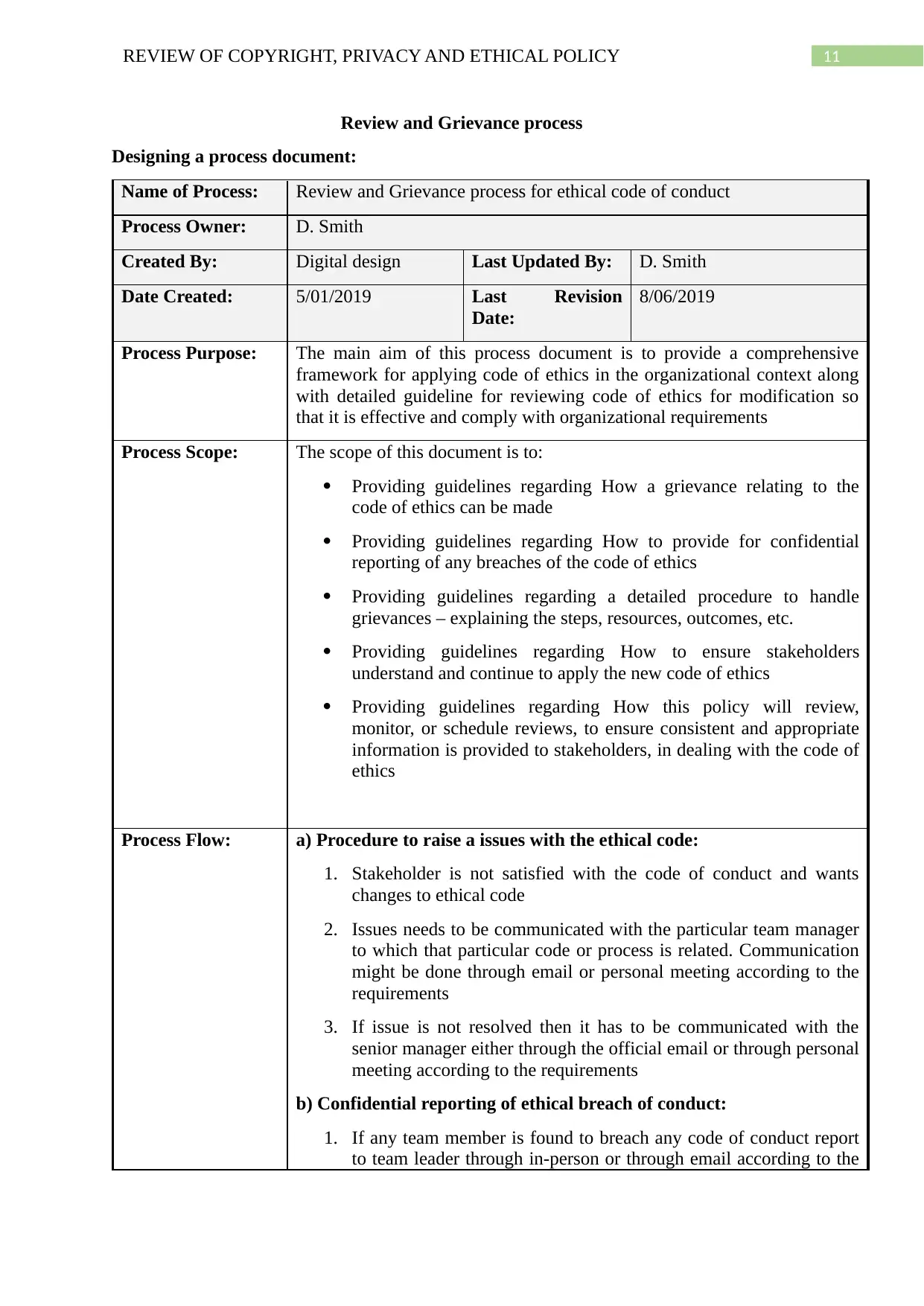
11REVIEW OF COPYRIGHT, PRIVACY AND ETHICAL POLICY
Review and Grievance process
Designing a process document:
Name of Process: Review and Grievance process for ethical code of conduct
Process Owner: D. Smith
Created By: Digital design Last Updated By: D. Smith
Date Created: 5/01/2019 Last Revision
Date:
8/06/2019
Process Purpose: The main aim of this process document is to provide a comprehensive
framework for applying code of ethics in the organizational context along
with detailed guideline for reviewing code of ethics for modification so
that it is effective and comply with organizational requirements
Process Scope: The scope of this document is to:
Providing guidelines regarding How a grievance relating to the
code of ethics can be made
Providing guidelines regarding How to provide for confidential
reporting of any breaches of the code of ethics
Providing guidelines regarding a detailed procedure to handle
grievances – explaining the steps, resources, outcomes, etc.
Providing guidelines regarding How to ensure stakeholders
understand and continue to apply the new code of ethics
Providing guidelines regarding How this policy will review,
monitor, or schedule reviews, to ensure consistent and appropriate
information is provided to stakeholders, in dealing with the code of
ethics
Process Flow: a) Procedure to raise a issues with the ethical code:
1. Stakeholder is not satisfied with the code of conduct and wants
changes to ethical code
2. Issues needs to be communicated with the particular team manager
to which that particular code or process is related. Communication
might be done through email or personal meeting according to the
requirements
3. If issue is not resolved then it has to be communicated with the
senior manager either through the official email or through personal
meeting according to the requirements
b) Confidential reporting of ethical breach of conduct:
1. If any team member is found to breach any code of conduct report
to team leader through in-person or through email according to the
Review and Grievance process
Designing a process document:
Name of Process: Review and Grievance process for ethical code of conduct
Process Owner: D. Smith
Created By: Digital design Last Updated By: D. Smith
Date Created: 5/01/2019 Last Revision
Date:
8/06/2019
Process Purpose: The main aim of this process document is to provide a comprehensive
framework for applying code of ethics in the organizational context along
with detailed guideline for reviewing code of ethics for modification so
that it is effective and comply with organizational requirements
Process Scope: The scope of this document is to:
Providing guidelines regarding How a grievance relating to the
code of ethics can be made
Providing guidelines regarding How to provide for confidential
reporting of any breaches of the code of ethics
Providing guidelines regarding a detailed procedure to handle
grievances – explaining the steps, resources, outcomes, etc.
Providing guidelines regarding How to ensure stakeholders
understand and continue to apply the new code of ethics
Providing guidelines regarding How this policy will review,
monitor, or schedule reviews, to ensure consistent and appropriate
information is provided to stakeholders, in dealing with the code of
ethics
Process Flow: a) Procedure to raise a issues with the ethical code:
1. Stakeholder is not satisfied with the code of conduct and wants
changes to ethical code
2. Issues needs to be communicated with the particular team manager
to which that particular code or process is related. Communication
might be done through email or personal meeting according to the
requirements
3. If issue is not resolved then it has to be communicated with the
senior manager either through the official email or through personal
meeting according to the requirements
b) Confidential reporting of ethical breach of conduct:
1. If any team member is found to breach any code of conduct report
to team leader through in-person or through email according to the
⊘ This is a preview!⊘
Do you want full access?
Subscribe today to unlock all pages.

Trusted by 1+ million students worldwide
1 out of 15
Related Documents
Your All-in-One AI-Powered Toolkit for Academic Success.
+13062052269
info@desklib.com
Available 24*7 on WhatsApp / Email
![[object Object]](/_next/static/media/star-bottom.7253800d.svg)
Unlock your academic potential
Copyright © 2020–2025 A2Z Services. All Rights Reserved. Developed and managed by ZUCOL.



